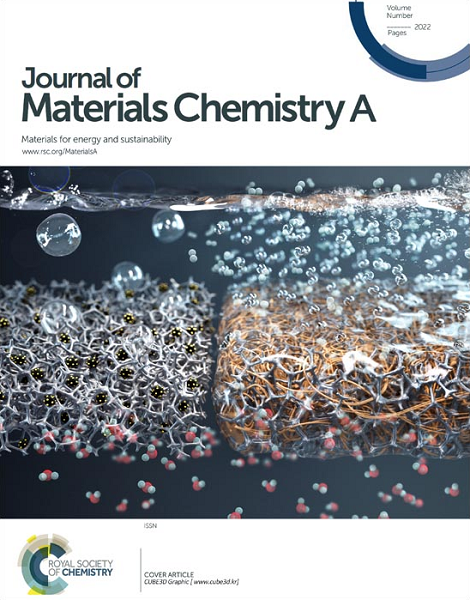偶氮受体连接介孔蜂窝状二氧化硅框架作为固态致色传感器捕捉环境/工业样品中的超痕量镉离子
IF 10.7
2区 材料科学
Q1 CHEMISTRY, PHYSICAL
引用次数: 0
摘要
这项研究的重点是一种无污染的超便携式固态光电化学传感器,用于检测环境、工业和非工业样品中有毒的 Cd2+。(E)-4-((4,5-二甲基噻唑-2-基)偶氮)-6-己基苯-1,3-二醇(DMTHBD)是一种两亲杂环偶氮受体,与中孔蜂窝结构二氧化硅整体框架(MHSF)紧密交错在一起。水兼容光学传感器(DMTHBD@MHSF)具有出色的结构完整性、表面形态和孔隙率。使用粉末 X 射线衍射、X 射线光电子能谱、傅立叶变换红外光谱、高分辨率透射电子显微镜、场发射扫描电子显微镜、能量色散 X 射线分析、选区电子衍射、元素图谱分析、热重/差热分析、布鲁诺-埃美特-泰勒(表面积)和巴雷特-乔伊纳-哈伦达(孔径分布)图对 MHSF 和 DMTHBD@MHSF 材料进行了表征。MHSF 显示出均匀分布的良好堆积的连续中孔通道,这些通道可加快受体分子在 MHSF 上的大量负载,并加快分析物向受体螯合位点的扩散。DMTHBD@MHSF 传感器对超痕量 Cd2+ 具有独一无二的选择性,只需使用极小的传感器剂量(3 毫克),就能在 ≤50 秒内实现与浓度相关的绚丽色变。在 1-400 微克/升的浓度范围内,可观察到从鲑鱼粉色到浓紫色的固态色调转变,在 0-150 g/L 之间具有线性信号响应,Cd2+ 的检测和定量限分别为 0.15 和 0.50 g/L。这种可再生传感器在恶劣的工作条件下具有极佳的稳定性和耐久性,即使长期储存也能保持可靠的性能。利用不同的实际样品验证了该传感器的实际应用,其 Cd2+ 的平均回收率≥99.43%,相对标准偏差≤1.65%。本文章由计算机程序翻译,如有差异,请以英文原文为准。
Azo-receptor conjoined mesoporous honeycomb silica framework as solid-state chromogenic sensor for capturing ultra-trace cadmium ions from environmental/industrial samples
The work focuses on a pollution-free ultra-portable solid-state opto-chemosensor for sensing noxious Cd2+ from environmental, industrial and non-industrial samples. An amphiphilic heterocyclic azo-receptor, (E)-4-((4,5-dimethylthiazol-2-yl)diazenyl)-6-hexylbenzene-1,3-diol (DMTHBD) is meticulously interlaced to the mesopore honeycomb structured silica monolith framework (MHSF). The aqua-compatible optical sensor (DMTHBD@MHSF) proffers remarkable structural integrity, surface morphology and porosity. The MHSF and DMTHBD@MHSF materials are characterized using powder X-ray diffraction, X-ray photoelectron spectroscopy, Fourier Transform infrared spectroscopy, high-resolution transmission electron microscopy, field-emission scanning electron microscopy, energy dispersive X-ray analysis, selected area electron diffraction, elemental mapping analysis, thermogravimetric/differential thermal analysis, Brunauer-Emmett-Teller (surface area) and Barrett-Joyner-Halenda (pore size distribution) plot. The MHSF shows a uniform distribution of well-packed continuous mesopore channels that expedite the voluminous loading of receptor molecules on MHSF and the analyte diffusion to the receptor chelating sites. The DMTHBD@MHSF sensor exhibits exclusive selectivity for ultra-trace Cd2+, with brilliant concentration correlative color metamorphosis in ≤50 s, using a minimal sensor dose (3 mg). A distinguishable solid-state hue transition from salmon pink to intense violet is spotted in the concentration range of 1-400 microg/L, with a linear signal response between 0-150 g/L, with detection and quantification limit of 0.15 and 0.50 g/L of Cd2+, respectively. The renewable sensor demonstrates excellent stability/durability under harsh working conditions, with reliable performance even after prolonged storage. The practical applications of the proposed sensor are authenticated using diverse actual samples, with an average recovery of ≥99.43% for Cd2+ and a relative standard deviation of ≤1.65%.
求助全文
通过发布文献求助,成功后即可免费获取论文全文。
去求助
来源期刊

Journal of Materials Chemistry A
CHEMISTRY, PHYSICAL-ENERGY & FUELS
CiteScore
19.50
自引率
5.00%
发文量
1892
审稿时长
1.5 months
期刊介绍:
The Journal of Materials Chemistry A, B & C covers a wide range of high-quality studies in the field of materials chemistry, with each section focusing on specific applications of the materials studied. Journal of Materials Chemistry A emphasizes applications in energy and sustainability, including topics such as artificial photosynthesis, batteries, and fuel cells. Journal of Materials Chemistry B focuses on applications in biology and medicine, while Journal of Materials Chemistry C covers applications in optical, magnetic, and electronic devices. Example topic areas within the scope of Journal of Materials Chemistry A include catalysis, green/sustainable materials, sensors, and water treatment, among others.
 求助内容:
求助内容: 应助结果提醒方式:
应助结果提醒方式:


